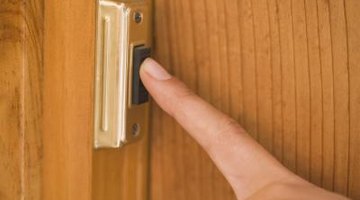How Does a Doorbell Chime Box Work?
The heart of all types of doorbells is an electromagnet. An electromagnet is simply a coil of wire wrapped around some type of magnetic metal. The form of that metal varies; in chime doorbell boxes, it takes the form of a piston, as explained in Section 2.


The Electromagnet
Electromagnets work by using magnetic fields to power something. The field is created when an electrical current is run through the wire. When wire is coiled, the effect is amplified. This magnetic field, like all magnetic fields, will flow between the north and south poles of the field and will be attracted to iron.
Holding down a doorbell button directs one of the household electrical currents to a transformer. The transformer greatly lowers the current from the standard 120-volts to 10 volts. Once it has been lowered, it then passes through the wires of the electromagnet, which creates a magnetic field and in turn powers the piston.
The Piston
Chime doorbell boxes use a special type of electromagnet called a solenoid. In a solenoid, the magnetic metal surrounded by the coiled wire is in the form of a piston. The piston is moved forwards and backwards by the magnetic field.
In the chime doorbell box, the piton is made up of an iron core which is then attached to a non-magnetic metal rod. When it is at rest, the doorbell is not being pushed, and no electricity is traveling through the coiled wire. When pushed, a spring pushes the piston over to the left side, which causes the iron core to protrude outside of the coiled wires.
The Ding and the Dong
On the right side of the iron core lies a tone bar. As the iron core slides to the right through the wire coil, it strikes the tone bar, which causes it to vibrate. This vibration produces a musical note; the "ding" sound of the doorbell. The piston will remain in contact with the right tone bar as long as electricity is flowing through the wire coils of the electromagnet. Once the doorbell has been released, however, electricity ceases to flow, and the magnetic field collapses. This causes the piston to snap back to the left, where it will strike a tone bar on the left side. The tone bar will vibrate, producing the "dong" tone.
The Drip Cap
- The heart of all types of doorbells is an electromagnet.
- An electromagnet is simply a coil of wire wrapped around some type of magnetic metal.
- In a solenoid, the magnetic metal surrounded by the coiled wire is in the form of a piston.
- When it is at rest, the doorbell is not being pushed, and no electricity is traveling through the coiled wire.
- As the iron core slides to the right through the wire coil, it strikes the tone bar, which causes it to vibrate.
Photo Credits
- www.rd.com
- www.rd.com
- Thinkstock Images/Comstock/Getty Images
More Articles



